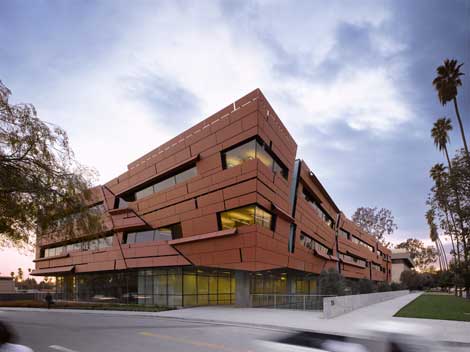Part of the Getty’s Pacific Standard Time initiative, MOCA’s “A New Sculpturalism” exhibition is an attempt to capture the tectonic shift of the last three decades from postmodern design to the new construction technologies and parametric forms found in Southern California architectural practices. Its first problem is it needs an audience who already has a working knowledge of the firms, the architects and their work. The multiple layers of the show are immersive but disorienting, both in terms of the experience and in terms of understanding why any of it matters. (How one understands any relationship to the time and development of these works is in the catalog, should one care to decipher it.)
The layers of the show have been muddy from inception to final execution, with curator conflicts, numerous delays, talk of canceling the show, and a last-minute push to execute it. Moreover, they lacked a definitive narrative or even a name for the show, and poor lighting submerged some of the work—including two Franklin Israel drawings of the Dan House (1995)—in shadow. One could focus on this, or one could talk about the powerhouse presence of Morphosis, Eric Owen Moss and Frank Gehry (who pulled out of the show and was later persuaded to return). Alongside the problems of coherence, however, it seems more important to focus on the individual works.
The only direction given to the viewer is that objects are grouped by typology. At the front of the central walkway, a model of the Bloom House (2010) by Greg Lynn opens the “residential” section. (His work bookends the exhibit at the back end with playful formal experiments in the “research” section.) Farther along, the model for Michal Maltzan’s One Santa Fe project (currently under construction) is located next to Saee Studio, whose abstract drawings of the Galzari House (1996) show an architecture of diaspora reflecting ideas of conflict relevant to that decade in Los Angeles. Unfortunately, all that can be derived from this perplexing juxtaposition of an abstract spatial exploration and a model of practicality in mixed-use development is that they exist simultaneously in Los Angeles.
A dominant Morphosis model of the Phare Tower in Paris stands at the center of the show, but if one strays off the path, one discovers more interesting 3D models by the firm of barnacle-like surfaces hidden away behind the wall.. Across from the tower is a large map of Culver City showcasing Eric Owen Moss’ Hayden Tract projects—an uncharacteristically engaging and clear demonstration of how the exhibition relates to its surroundings.
Young architect Alexis Rochas’ curving video boards, hung from the ceiling throughout the exhibition, project sterile interviews that are difficult to extract meaning from even as they “fill” the space. Not to be missed, however, are the front pavilions: the Xten architecture, Wes Jones and his graphic drawings, the journals of Roto Architects, giant prints from Ball-Nogues Studio, and the hanging models of Hitoshe Abe.
“A New Sculpturalism” throws together a plethora of architectural examples for its audience with little in the way of interpretative models to establish their historical and cultural relevance. While it tries to relate the current practices of architecture to the rapid movements of technology and to the global connectivity that entangles practitioners in LA, on the whole “A New Sculpturalism” represents a missed opportunity.


